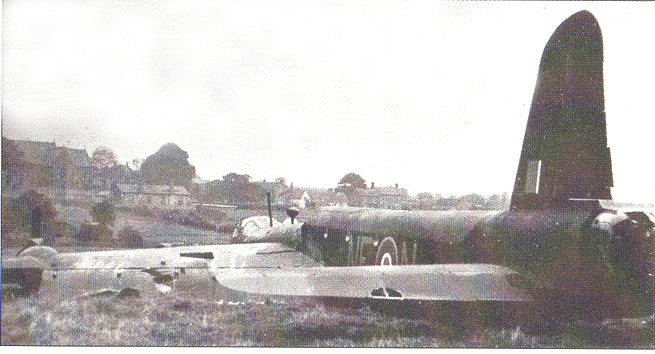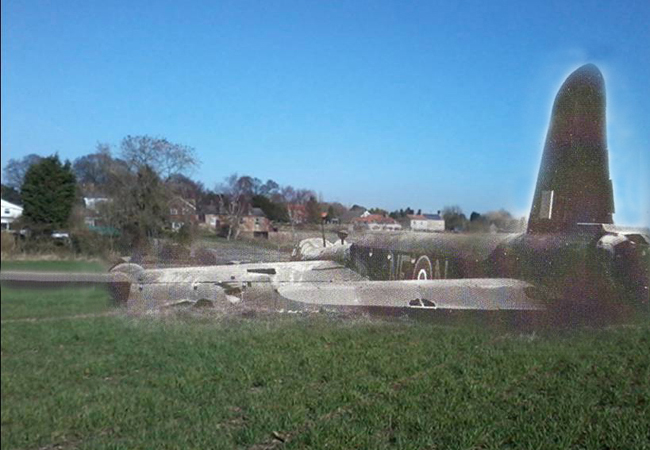Page 1 of 1
CRASHED STIRLING LUDFORD MAGNA
Posted: Fri Mar 14, 2014 2:00 pm
by bandlaw49
A couple of grainy shots (sorry for that) showing LJ932 138 SD Sqn down and dirty just on the edge of Ludford Magna village, Lincolnshire.
Date 29 Sep 44 - returning from SOE op in Denmark....shot up by a Ju 88 which destroyed the starboard inner. On emergency approach to Ludford both port motors failed and NF N crash landed. Pilot F/L R W Reed DFC was injured as to the F/E F/O C K Curtis who received the DFC for his actions that night. The remainder of the crew were safr. Time of crash; 02.35hrs.

- Source Aeroplane Mag
- Ludford Stirling 138 Sqn.jpg (250.35 KiB) Viewed 13390 times

- Source The Stirling File
- LUDFORD STIRLING HEAD ON.jpg (75.88 KiB) Viewed 13390 times

- then and now
- lud stirling village.jpg (219.74 KiB) Viewed 13390 times
Regards Bandlaw
Re: CRASHED STIRLING LUDFORD MAGNA
Posted: Fri Mar 14, 2014 2:05 pm
by bandlaw49
Location photos of the crash landing at Ludford.
Regads Bandlaw

- google maps
- LUD MAP location.jpg (196.65 KiB) Viewed 13389 times

- lud merger complete.jpg (201.14 KiB) Viewed 13389 times
Re: CRASHED STIRLING LUDFORD MAGNA
Posted: Fri Mar 14, 2014 3:06 pm
by K4KittyCrew
Your efforts are greatly appreciated, 'Bandlaw' ............ welcome to the forum and many thanks for posting these details and images.
John
Re: CRASHED STIRLING LUDFORD MAGNA
Posted: Fri Mar 14, 2014 8:49 pm
by Stirling Project
Fascinating! Wonder how many occupants of those nearby know that their houses had a close escape?
John L
Re: CRASHED STIRLING LUDFORD MAGNA
Posted: Sat Mar 15, 2014 1:24 am
by wayne
Great set of photo's.
I'm glad the crew were ok.
Thanks for sharing with us

Cheers,
Wayne.
Re: CRASHED STIRLING LUDFORD MAGNA
Posted: Sat Mar 15, 2014 7:55 am
by AlanW
And it did'nt even warrant a mention in the ORB. Just states "completed"
Re: CRASHED STIRLING LUDFORD MAGNA
Posted: Sat Mar 15, 2014 5:39 pm
by smudgersmith218
Gents,
Great post, a joy to view and read.
Steve
Re: CRASHED STIRLING LUDFORD MAGNA
Posted: Sat Mar 15, 2014 7:25 pm
by bandlaw49
Hello Chaps,
Thnak you for the encouraging responce to this particular item. Please find attached the crash site in relation to the airfield. The view is North to the top, so it would appear S/Ldr Reed had perhaps approached from the South West end of the main runway, tried to overshoot and then lost power on his port motors. This would account for the position of the wreck.
What is not apparent on the photos is the slope towards this village......I dare say a few anxious moments were endured by the pilot and F/Eng as the Stirling slid along at a rate of knots. A lucky night for both crew and villagers!
Cheers John (Bandlaw)

- 440.jpg (207.53 KiB) Viewed 13361 times
Re: CRASHED STIRLING LUDFORD MAGNA
Posted: Wed Apr 23, 2014 2:57 pm
by Ludford101
Hi John ... just catching up on forum posts and noticed this one on Ludford

Interesting and very well put together ... I knew about the two 101 lancasters that made an inpromtu stop off in what we call 'School Field'... but not the Stirling one...

The field is part of my better half's farm and I have over the years found a few bits and pieces when out metal detecting at the top of the field below the main runway .... parts of the Lancs ... now I have a new target further west to aim at ...


Just hope any pieces are not obscuring a pot or roman coins...

Cheers
Gary
Re: CRASHED STIRLING LUDFORD MAGNA
Posted: Sat Apr 26, 2014 8:09 pm
by eye4wings
Looking at the photos and maps posted I found myself wondering how the aircraft came to rest where shown - which position looks well deduced from landmarks. An approach from the South-west seems most likely for an aircraft that had been shot up and with a missing engine. However from the front view it appears that it was the PORT inner rather than the starboard inner that suffered the battle damage. The prop is missing - together with the front casing of the engine - which was probably lost at the time of the attack, there being no major damage to the cowling.
With the port inner dead the pilot would have had to retrim rudder for the return journey. He may also have deployed some flap for some part of the flight home and they are fully deployed for landing, which appears to have been a wheels-up one. When the remaining port engine failed on final approach (fuel starvation - leaking tank on the side that took the main damage in the attack?) the pilot would have been exerting a lot of effort in applying right rudder, which presumably accounts for the fact that the port outer propeller was unfeathered and the upper blade undamaged. At some point, having slewed left and sliding across the se-nw runway he would have shut down the starboard engines, but it seems that the props were still turning when the aircraft reached the field beyond the airfield boundary and began to buck and dig into the soft ploughed ground as all of the starboard inner blades are bent. The aircraft also broke it's back around this time. At the point where the aircraft came to rest it had evidently slewed to the right. I imagine this was because of the right rudder applied to compensate for the missing engine(s) - although I find myself a little surprised that the rudder had that much authority at that slow speed. The slewing would be consistent with the fact that the port side had come to rest lower than the starboard.
Or it could have been that the wind was blowing from the south-east - which would have been a big factor in the decision to leave the wheels up (even assuming that they were still operable).
Well, that's my theory as to the sequence of events - and I have little more than my experiences of flying the 1:10 scale model to work on. For the model a wheels-up landing is less eventful than one with wheels down (so far) as I have adjusted the wheels not to retract to the full scale position with just that eventuality in mind. No props get damaged at all - which is a nice bonus!
Incidentally I suspect that an overshoot on three engines could have resulted in a total loss - especially if there was a cross-wind!
Robin